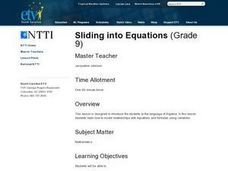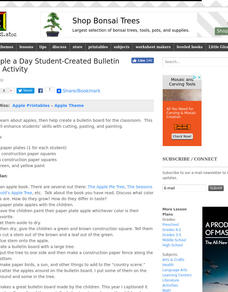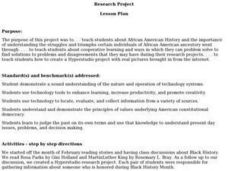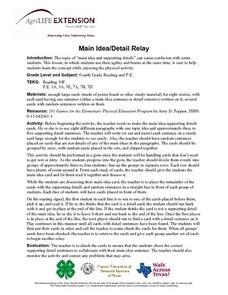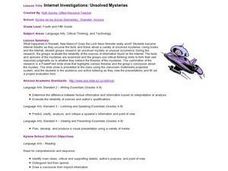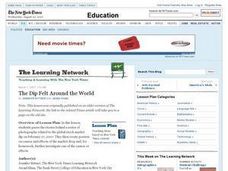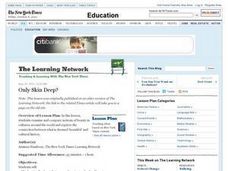Curated OER
Sliding into Equations
Ninth graders translate sentences into equations. They translate equations into sentences. They solve real life problems using verbal models to write equations. They create a problem solution graphic organizer in their journals.
Curated OER
Community Close-Up Brochures
Students express a personal view of the land areas, buildings, schools, stores, and cultural events that make their community unique. They design and create a "Community Brochure" that would attract new residents or visitors to their...
Curated OER
Physical Changes of Water
Students observe changes in water. For this lesson about water and its forms, students perform an experiment to determine how water changes. Students analyze what causes water to be solid, liquid, or gas. Students record their...
Curated OER
Things That Don't Belong
In this sorting and classifying objects worksheet, students identify the pictures that do not belong with the Halloween pictures. Students find 2 pictures that do not belong.
Curated OER
An Apple a Day
Learners study apples and then paint apples whichever color is their favorite apple color. They help create a bulletin board for the classroom. They graph the different colors of apples found on the board.
Curated OER
Living things
In this living things worksheet, students color the pictures of living things. Students circle 3 pictures and have 5 to choose from.
Curated OER
Birthday Moons
Students examine the lunar phases by locating and graphing the Moon phase of their own birthdays. They listen to and discuss lunar myths and create their own Birthday Moon Stories.
Curated OER
Negative vs. Positive Thoughts
Seventh graders see themselves and how they think they are seen, which can be sometimes quite different. Self-esteem portrait allows the student to say how they think others see them, how they see themselves, and how others do indeed see...
Curated OER
The Life Cycle of the Butterfly
First graders, after listening to fictional and non-fictional literature about caterpillars, and observing caterpillars from egg to butterfly, write a "biography" of a caterpillar using appropriate vocabulary and time lines.
Curated OER
Research Project
Students fill out a form which asked the WHO, WHAT, WHEN, WHERE, and WHY about the person they were assigned to research, they gather their information from different web sites on Lightspan and Yahooligans. They create a HyperStudio and...
Curated OER
A Model Estuary
Students assemble a poster of an estuary showing the five communities of animals and plants that inhabit the estuary. They research the concept of an estuary and find photographs or diagrams of various estuaries to identify and see the...
Curated OER
Graphing Favorite Fruit
Third graders take poll and sort data, enter the data to create a spreadsheet and create bar and pie graphs.
Curated OER
Furniture Arrangement
Students identify that the arrangement of furniture is an extension of space planning and a good arrangement of furniture will be both functional and pleasing. They also fill in the Furniture Arrangement worksheet during the lecture and...
Curated OER
Main Idea/Detail Relay
Fourth graders discuss the difference between main ideas and supporting details. They use large placement cards made by the teacher with main idea and supporting detail statements on them to practice.
Curated OER
Wiggley Worms
Learners investigate how worms affect plant growth. In this biology activity, students construct a worm ecosystem in a plastic 2 liter bottle and plant a seed in the soil. They later compare the ecosystems with worms to ones...
Curated OER
Internet Investigations: Unsolved Mysteries
Students conduct Internet research to investigate the facts and fiction of various unsolved mysteries. They examine the facts and opinions of the mysteries, and create a Powerpoint slide show to present the theories and the group's...
Curated OER
The Dip Felt Around the World
Students share their opinions about a story about a sudden decline in China's stock markets. After reading an article, they identify the global impact of China's falling stock markets. They create a cause and effect map about the fall...
Curated OER
Only Skin Deep
Students examine and compare notions of beauty in cultures around the world and explore the connection between what is deemed 'beautiful' and cultural history. They Develop a "Beauty Around the World" collage representing beauty...
Curated OER
1950's Rock and Roll
High schoolers complete an Individual Artist Information Sheet on famous 1950's Rock and Roll musician. They read one of the chapeters on "Elvis Pressley, Little Richard, Chuck Berry, Rockabilly, Jerry Lee Lewis, The Everly Brothers,...
Curated OER
Understanding Characters
Students analyzing characters from a story by creating an article about one. In this story analysis lesson, students read Charlie and the Chocolate Factory by Roald Dahl, and pick one character to write descriptively about....
Curated OER
Food Label Scavenger Hunt Lesson: Worksheet with Twenty-one Food Lab
Young scholars investigate the nutritional value of foods. In this scavenger hunt lesson, students compare various foods using food labels to determine their calories, fat, saturated fat, sodium, sugar, and protein. There is a link to...
Curated OER
Creating an Online Disease Pamphlet Using Online and Print Resources
Eight grade health learners choose a disease to research. They compose their information and create a brochure to give to people who are affected by their chose disease. They address the history, causes, symptoms, diagnosis, and...
Curated OER
Arkansas' Top Ten Events of the Century....Says Who? Why? Deciding What is Important in History
Middle and high schoolers work in small groups to compare four different lists published in the Arkansas Times newspaper which chose the "top ten" Arkansas news events of the 20th century. Learners look for similarities and differences...
Curated OER
Initial Fraction Ideas Lesson 10: Overview
Third graders use strips of paper to find equivalent fractions. They will fold paper into thirds and shade 2/3 of the paper. Then fold the same paper in six parts and predict how many parts will be shaded. They will repeat again folding...
